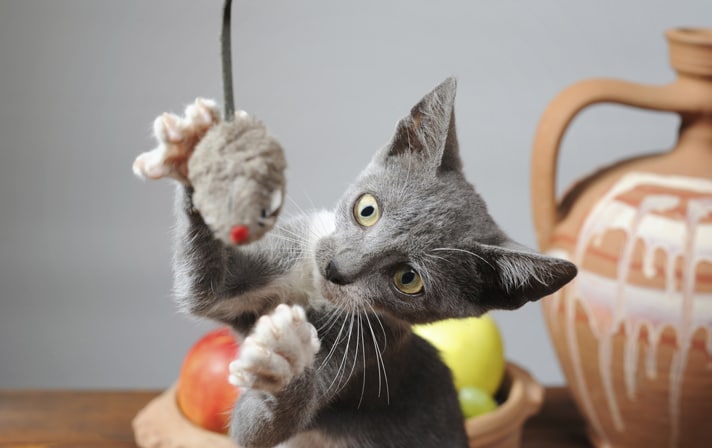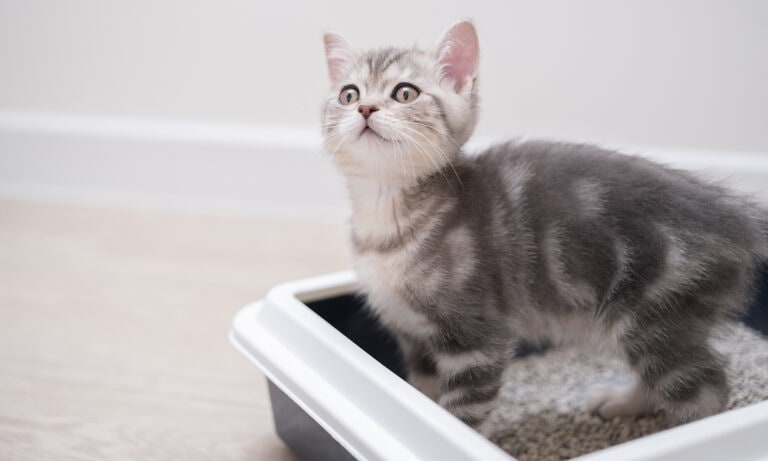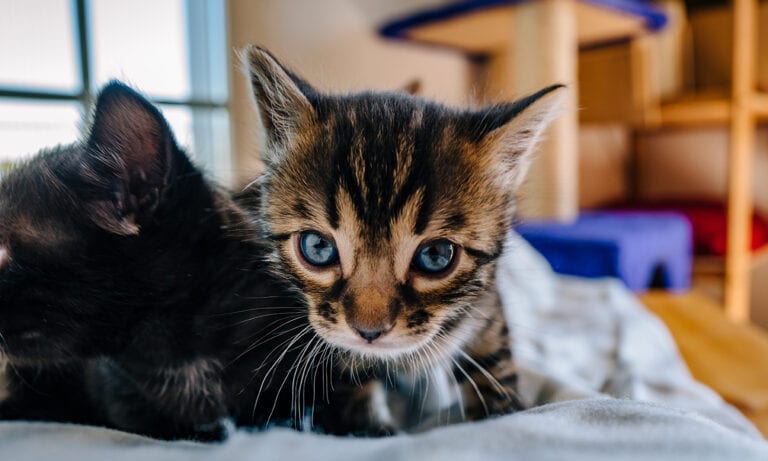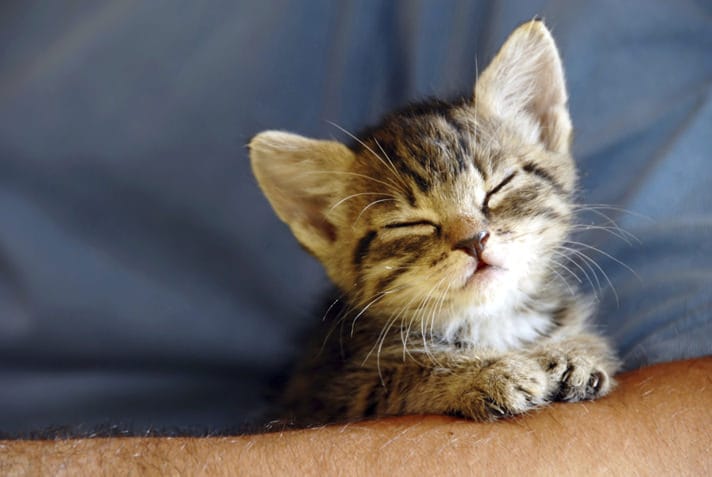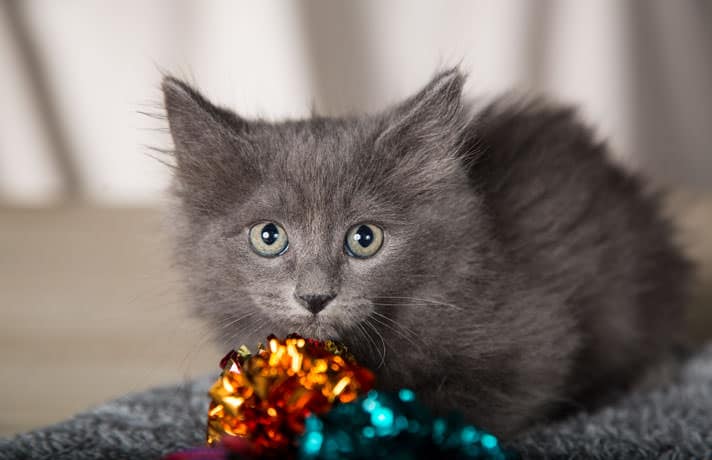Max was just 4 months old when I adopted him from Saving Grace Animal Shelter. When we met, the little guy with a tuxedo coat appeared healthy and alert, and he got along well with the other adoptables in his temporary kitty condo.
He gazed at me with those golden eyes, and I simply had to add him to my family. I brought him home, took him into the spare bedroom, opened his carrier and allowed him to cautiously explore.
Once he felt comfortable in the new space, his real personality — and activity level — came out. Curious, energetic and fearless, Max dashed about like a madman, err, madcat. Pouncing on his cat toys, attacking them with his needle teeth and clawing up the curtains, Max had some serious spunk!
Though my instinct was to tamp down that Tasmanian devil-like behavior, Ernie Ward, DVM, founder of the Association for Pet Obesity Prevention, says that kind of playful spirit should be encouraged in kittens. “When they’re young, kitty cats are going to be much more active and playful, just like people,” he says. “So when you see your kitten doing that, encourage it, don’t discourage it, and then try to maintain that activity as lifelong habits.”
Learning How To Cat
A cat is considered a kitten until she’s 7 months old, when she reaches sexual maturity. During that time, her body is growing, her senses are developing and her instinctual behaviors are forming. She’s learning how to be a cat.
Most of her waking hours will be spent playing and interacting with her companions — both two- and four-legged, says animal behaviorist Sharon Crowell-Davis, DVM. “Play behavior with companions peaks in the third and fourth months,” she says. “And at 5 months old, you’ll see more solitary hunting and stalking prey.”
As your kitten engages in these innate hunting and stalking behaviors, she’s also developing physical skills that she will need as a teenage and adult cat. She’s learning how to jump, balance and climb, Ward says. She’s unleashing what he calls her “inner kitty predator.” “Kittens have a built-in predatory drive,” he says. “It’s instinctive, and this is why you see them hiding in boxes. This is why they chase a wad of paper on the floor.
This is stuff that really excites them.” It’s your job as pet owner to encourage your kitten to tap into her wild side, Ward says. “If your kitten says, ‘Let’s play, play, play, play, play,’ make it happen and think, this is setting her up for a lifetime of health,” he says.
Channeling Your Kitten’s Energy
Your little panther may want to play 23 hours a day, but her body is actually designed to perform short bursts of intense activity, just like a wildcat, Ward says.
“A good starting point is three 5-minute play periods a day, because we want to tap into this predatory instinct,” he says. “So this can be with a laser pointer. It can be remote control cars. It can be feather dancers that you dangle and they chase around. There are many motion- and sound-sensitive automated toys now that mimic a mouse or ball rolling around.”
Remember those developmental milestones that Crowell-Davis mentioned? Well here’s how you can foster them while helping your kitten develop some panther-like coordination.
When your kitten is 3 or 4 months old, go for more interactive activities, like playing hide-and-seek and teasing her with a feather wand or mouse on a string.
When she’s 5 months and older, work on her individual prey drive by shining a laser pointer on the wall from across the room, offering her a crackle ball to bat around, and setting free a battery-operated mouse to chase.
Stock Up On Playtime Essentials
“Learning to play is essential for the development of kittens because it teaches them important skills that they will need as adults,” says Andrew Edney, DVM, author of the ASPCA Complete Cat Care Manual. Edney recommends stocking your kitten’s toy box with these essentials:
(1) Stuffed mice, like the KONG Refillable feather mouse catnip cat toy: Perfect for solitary play, your kitten will bat these mice around and chase them — just like the real thing. When she’s older, try offering a mouse or pouch stuffed with catnip. She’ll be purring in ecstasy.
(2) Bouncy or crackle balls, like the KONG tennis balls cat toys: Small, bouncy or noisemaking balls are ideal for your kitten to pat and push around with her paws. Just be ready to retrieve them from behind doors and underneath couches.
(3) Cardboard boxes, just like the Chewy box your supplies come in: Cats of all ages love boxes, and those with a hole in the lid are ideal for playing games of hide-and-seek with you and your other four-legged family members.
(4) Feather wand, like the Pet Fit For Life 3 feather dual rod wand cat toy: When you wave a feather wand erratically up and down, it looks like a troubled bird or butterfly – and that will trigger your kitten’s predatory instinct.
(5) Toy on a string or dangling treat, like the Friskies Pull ‘n Play tender strings tuna and crab cat treats: Cats are fascinated by objects that are dangled or pulled in front of their nose. A feather or stuffed mouse tied to piece of string or a fishing wand-type toy, or even a string-like treat, will keep your cat amused for hours – well, a few minutes at least.
Cat toys and activities like these will grow their pouncing and chasing abilities, make them more agile and nimble, and better their coordination. Plus, it strengthens the bond between you and your tiny pal.
“For their entire lives, cats are going to be really good at sprinting, pouncing and leaping,” Ward says. “We want to make sure our kitty cat is moving.” My tuxedo-clad Max recently celebrated his first birthday. He’s still a little spaz, but he turned out to be a vicious rodent killer. (So long, mouse population!) I attribute his mad hunting skills to hours of playtime with a mouse on a string. And some tasty cat treats, such as Temptations Mixups Catnip Fever cat treats, as rewards for a job well done. Now if only he would stop attacking my ankles …
Featured Image: Dragi52/iStock/Thinkstock
Share:
